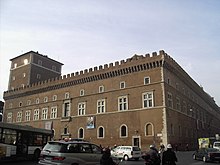Fascist Grand Council
|
Grand Council of Fascism Gran Consiglio del Fascismo |
|
|---|---|
 |
|
| Leadership | |
|
President of the Council
|
|
| Meeting place | |
 |
|
The Grand Council of Fascism (Italian: Gran Consiglio del Fascismo) was the main body of Mussolini's Fascist government in Italy. A body which held and applied great power to control the institutions of government, it was created as a party body in 1923 and became a state body on 9 December 1928. The council usually met at the Palazzo Venezia, Rome, which was also the seat of head of the Italian government.
Its members, selected among the party's gerarchi, were as follows:
Essentially, the council held these powers:
The Grand Council meetings were convened by the Prime Minister himself, and all decree and laws could only be legalized after receiving his approval. In contrast to the Führerprinzip government model in Nazi Germany, the Grand Council retained the power to recommend that the King of Italy remove the Prime Minister from office. As all the former governing institutions had been subordinated to the Fascist party, the Council was the only check on Mussolini's power.
A majority of the Grand Council (19 votes against 8, with one abstention) voted, in the early morning of 25 July 1943, for Dino Grandi's Order of the Day (Ordine del Giorno Grandi) that bloodlessly deposed Mussolini following the Allied invasion of Sicily. Among the 19 deposing votes were those of Mussolini's son-in-law Galeazzo Ciano, who had been former minister of foreign affairs, and the influential marshall Emilio De Bono. Those two persons, and another three internal opponents of Mussolini, who by the help of German troops could maintain his fascist regime in northern Italy, were sentenced to death in Verona on 8 January 1944 and killed three days later.
...
Wikipedia
